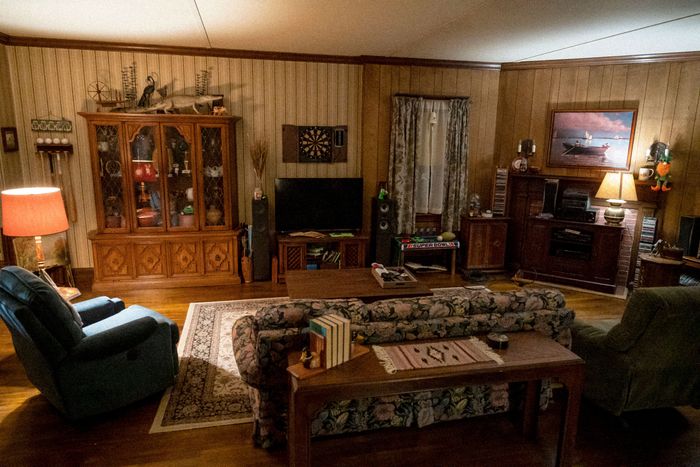The McRoberts’s living room under the multi-cam lights.
Photo: Jojo Whilden/AMC
The same room with a fourth wall and ceiling added for a single cam scene.
Photo: Jojo Whilden/AMC
When they first started discussing Kevin, Armstrong and DiGregorio imagined a show that felt like moving between an episode of Roseanne and David O. Russell’s movie The Fighter, two divergent glimpses of blue-collar family life. The transitions needed to be purposeful without being too drastic — “to cut seamlessly and just be something you don’t even think about” while you’re watching, says Dokoza.
“Audio really helps you get out of multi-cam and right into Allison’s point of view,” says Rodriguez. In the pilot, a ringing in Allison’s head often signals the switch. The slamming of a door in the multi-cam works as an effective way to cut to the single cam. There are also Easter eggs sprinkled throughout the multi-cam that confirm information we’ve learned elsewhere, like the brand-new sneakers Kevin is always wearing — evidence that he really has been spending all of the couple’s savings on frivolous things for himself.
Production designer Tony Fanning used the same sets for locations that show up in both formats, angling out the two sides for multi-cam purposes and sliding in a fourth wall and a ceiling for the single. Astonishingly, none of the other details, down to the table lamps, change at all. What does change is the way these environments are shot and lit: While the multi-cam makes the home look open and inviting, for the single cam Rodriguez and Dokoza chose angles that capture the fourth wall and the ceiling. Sunlight streaks in sparingly, making everything look dimmer and drearier.
Fanning had to carefully calibrate the color palette so it would work in both versions. “You couldn’t get too crazy with pattern and the brightness of color because it would look fake or false in the single-camera world,” he says. Paint, wallpaper, and other pieces were nicked and scuffed to appear worn and torn, but not so worn and torn that they look out of place in the multi-cam. Costumes similarly did double duty. In the pilot, Allison tears a hole in her sweater in the single cam, but we never see the snag in the multi-cam scenes; it’s covered by a jacket, and the cameras don’t zoom in close enough to capture it.
In so many ways, Kevin Can F**k Himself is telling its audience to look closer — at Allison, at jokes that punch down, at gender dynamics on TV and in real life, and at how human beings, women in particular, can do a better job of supporting one another. The series arrives during a pandemic that has caused particularly intense stress for women and might have already prompted some to think about the same issues that are plaguing Allison: what they want their lives or marriages to be and whether it’s even possible to get there from where they are now.
“I think if this show can make even one woman see herself and say, Oh, right. This is the life that I could have for the rest of my life, but I don’t want that. I want to change, then I think the show will have been a massive success,” says Murphy. She hopes that the opening scene, where Allison smashes her beer glass, will resonate with anyone who has kinda had it after the past year. “I wish for millions and millions and millions of women out there that they just had a nice, fake breakaway beer mug to shatter,” she says. “Because, ooh — that gets out a whole lot of pent-up aggression.”




